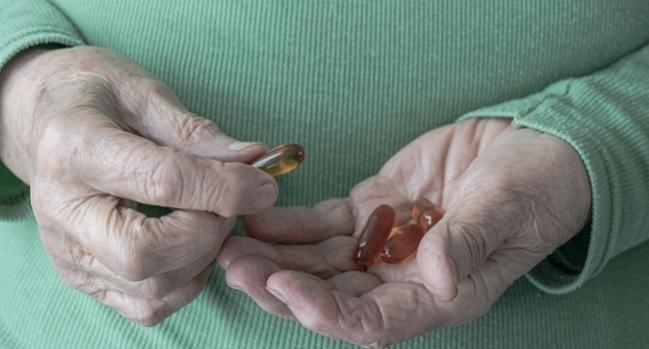OMEMI: Omega-3 Fatty Acids No Help in Elderly MI Patients
The results are less relevant for current practice because patients were not selected for high triglyceride levels, one expert says.

Adding omega-3 fatty acids to standard therapies for secondary prevention does not improve outcomes in elderly patients who have recently had an MI, the OMEMI trial shows.
Through 2 years, the rate of the primary composite outcome (nonfatal MI, unscheduled revascularization, stroke, hospitalization for heart failure, or all-cause death) was 21.4% in patients who received omega-3 fatty acids and 20.0% in patients who received a corn oil placebo (HR 1.07; 95% CI 0.82-1.41), according to Are Annesønn Kalstad, MD (Oslo University Hospital Ullevål, Norway).
There were no between-group differences for any of the individual components of the composite endpoint, he reported during a session at the virtual American Heart Association 2020 Scientific Sessions that also included a presentation of the negative—and controversial—STRENGTH results. But there was a numerically higher rate of new-onset A-fib in the fish oil group (7.2% vs 4.0%; HR 1.84; 95% CI 0.98-3.45). “We cannot rule out potential harm in increasing the risk of atrial fibrillation,” Kalstad said.
The findings, published simultaneously online in Circulation, “do not support omega-3 fatty acid preparations for secondary prevention in elderly patients,” he concluded.
Residual Risk in the Elderly
After an acute MI, older patients remain at higher risk for adverse outcomes compared with their younger counterparts, even with modern approaches to secondary prevention, Kalstad noted. Clinical trials of contemporary treatments include mostly younger patients, and thus the results may have limited validity in older individuals, who have been shown to have elevated risks of adverse events, he added.
So there is a clear opportunity for improvements in secondary prevention in the older age groups, he said. “Omega-3 fatty acids have the potential to offer cardiovascular protection without significant harm in potentially vulnerable elderly patients,” he said.
OMEMI explored this hypothesis in 1,014 patients ages 70 to 82 (mean age 74; 29% women) who had had an MI 2 to 8 weeks prior to randomization. They were assigned to receive marine omega-3 fatty acids at a dose of 1.8 g/day—containing 930 mg eicosapentaenoic acid (EPA) and 660 mg docosahexaenoic acid (DHA)—or corn oil placebo.
Prior to the index MI, 46% of patients had a history of CVD. Most patients were taking statins (96%), dual antiplatelet therapy (86%), and antihypertensives (72%) at baseline, and a large proportion (41%) were already taking an omega-3 fatty acid supplement or cod liver oil.
Self-reported adherence to study treatment was 88% in both groups, and serum fatty acid measurements confirmed good adherence. Median increases in EPA and DHA were 87% and 16% in the fish oil group, with decreases of 13% and 8%, respectively, seen in the control arm.
That did not translate into any clinical benefit, however. The lack of any difference in terms of the primary composite outcome was consistent across subgroups and in a per-protocol analysis.
The main safety outcome was major bleeding, and there was no difference between the fish oil and placebo arms (10.7% vs 11.0%; P = 0.87).
No patients discontinued study treatment due to bleeding, Kalstad reported. The most common reasons for discontinuation, he said, were hospitalization for other diseases that affected the ability to continue, difficulty swallowing capsules, and nonspecific GI symptoms, which were well balanced between groups.
Limited Applicability to Current Practice
Salim Virani, MD, PhD (Baylor College of Medicine, Houston, TX), said the findings are not relevant to current practice because patients were not selected based on high triglyceride levels, which was done in REDUCE-IT and STRENGTH.
The mean triglyceride level in OMEMI was only 111.4 mg/dL, “so it does not identify the kinds of patients in whom we would use triglyceride-lowering therapies” as part of a risk-based approach, said Virani, who is chair of the American College of Cardiology’s prevention section and leadership council.
He noted that the GISSI-Prevenzione trial published in 1999 showed that supplementation with omega-3 fatty acids and vitamin E improved outcomes after MI. But the treatment of MI is much different two decades later, with intensive statin therapy, greater use of revascularization, the availability of DES, and use of more-potent antiplatelet therapy. Taking that into consideration, “I think the incremental benefit [of omega-3 fatty acids] will be low, especially when you don’t even have inclusion criteria that target the risk that that therapy is addressing,” Virani said. “In this case, it would be triglycerides.”
It’s known that triglycerides contribute to the development of atherosclerosis and that patients with high triglyceride levels have an elevated cardiovascular risk, he pointed out. “The question is: how do we lower that risk?” he said, advocating for a more-targeted approach to using omega-3 fatty acids.
“To me, [by] reserving these therapies for patients who have the highest risk of cardiovascular events, we probably are on the way of making further reduction in what we call the residual risk when you have treated your patients with revascularization, when you’ve lowered LDL cholesterol levels enough, and then you’re trying to look for things that you can further address in these very high-risk patients,” Virani said.
Todd Neale is the Associate News Editor for TCTMD and a Senior Medical Journalist. He got his start in journalism at …
Read Full BioSources
Kalstad AA, Myhre PL, Laake K, et al. Effects of n-3 fatty acid supplements in elderly patients after myocardial infarction: a randomized controlled trial. Circulation. 2020;Epub ahead of print.
Disclosures
- The study was supported by nonrestricted grants by the Stein Erik Hagen Foundation for Clinical Heart Research, the Olav Thons Foundation, and the Tom Wilhelmsen Foundation, all in Oslo. Active study drug and placebo were supplied by Orkla Health, Oslo.
- Kalstad reports no relevant conflicts of interest.
- Virani reports research support from the Department of Veterans Affairs and the World Health Federation, as well as an honorarium from the American College of Cardiology.


Comments